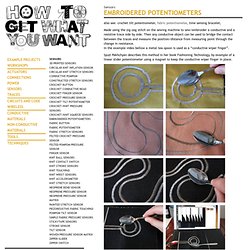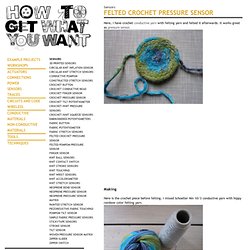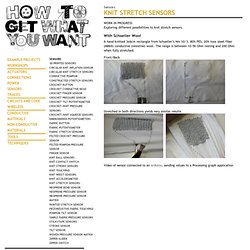

Textile Sensors.
Knitted Stretch Sensor with LEDs. Embroidered Potentiometers. Also see: crochet tilt potentiometer, fabric potentiometer, time sensing bracelet, Made using the zig-zag stitch on the sewing machine to sew/embroider a conductive and a resistive trace side by side.

Then any conductive object can be used to bridge the contact between the traces and measure the position/distance from measuring point through the change in resistance. In the example video bellow a metal tea-spoon is used as a “conductive wiper finger”. Syuzi Pakhchyan describes this method in her book Fashioning Technology, by example of a linear slider potentiometer using a magnet to keep the conductive wiper finger in place. Video. Textile Sensor KITS by Plusea. Felted Crochet Pressure Sensor. Here, I have crochet conductive yarn with felting yarn and felted it afterwards.

It works great as pressure sensor. Making Here is the crochet piece before felting. Neoprene Pressure Sensor. Also: neoprene pressure sensor, conductive thread Pressure Sensor Stitching conductive thread into neoprene to create a pressure sensitive pad.

This sensor is very similar to the Fabric bend sensor or vis-versa. And also close to the Fabric Pressure Sensor, but the difference is that the conductive surface is minimized by stitching only a few stitches on either side with conductive thread. This creates a good fingertip pressure range. Zipper Switch. A Zipper is a great clothing material that can be converted into sensors.

Zipper switch is a known technique used in many projects like TV-B-Gone-Hoodie by Becky Stern. It is also introduced in “Fashioning Technology” book by Syuzi Pakhchyan. There is a great tutorial from ITP here >> Anyhow, I had to make one of my own. so I did it. And yes, it works very good and it is relatively easy to make. Knit Stretch Sensors. WORK IN PROGRESS Exploring different possibilities to knit stretch sensors.

With Schoeller Wool A hand knitted 3x6cm rectangle from Schoeller’s Nm 10/3, 80% PES, 20% Inox steel fiber (M869) conductive (resistive) wool. The range is between 10-5K Ohm resting and 200 Ohm when fully stretched. Front/Back Stretched in both directions yields very similar results Video of sensor connected to an arduino, sending values to a Processing graph application Video of sensor connected to a battery and an LED Hand knitted, conductive yarn mixed with normal yarns Hand knitted single and double rib stitch mixed with conductive yarn from Schoeller, Nm 50/2 60/40 Pes/Inox @ Euros 65.00/kg (25,000 metres/kg). Crochet, conductive yarn mixed with normal yarns Mesh stitch crochet, normal yarn mixed with conductive yarn from Schoeller, Nm 50/2 60/40 Pes/Inox @ Euros 65.00/kg (25,000 metres/kg). Stretch test: Normal 200-230k ohm >> stretched 5-10k ohm #ST3004: Treble Crochet with 1 stitch interval From Plug and Wear. Technology - Soft-circuits - How to Make Instructables. Guide.
Conductive Fabric Pressure Sensor. Sew together conductive fabric and anti-static plastic to make your own fabric pressure sensor!

These step-by-step instructions will show you how to make your own fabric pressure sensor. It mentions two different variations, depending on if you use stretchy or non-stretchy fabric. The materials used for the sensor are basically cheap and off-the-shelf. There are other places that sell conductive fabrics and Velostat, but LessEMF is a convenient option for both, especially for shipping within North America. Velostat is the brand name for the plastic bags in which sensitive electronic components are packaged in. To make the sensor fully fabric one can use EeonTex(TM) conductive textile (www.eeonyx.com) instead of the plastic Velostat, but at the moment EeonTex(TM) conductive textile is only available in a minimum of 100yds. To see what we use this technology for visit:www.massage-me.atwww.plusea.atwww.kobakant.at.
How-To: Knit stretch sensor. Sewing an eTextile circuit tutorial for The Kid. Upcoming Voodoo Doll Workshop with Catarina Mota on December 1st at Indiana University! Soft Circuit Voodoo Doll Workshop In this free workshop we'll cover the basics of soft circuits (materials and techniques) and then make folk art textile voodoo dolls whose eyes light up when punctured with a needle.

All tools and materials (dolls, conductive spandex, conductive thread, etc.) will be provided. You may bring your own doll to modify, if you prefer! Example dolls can be found at: